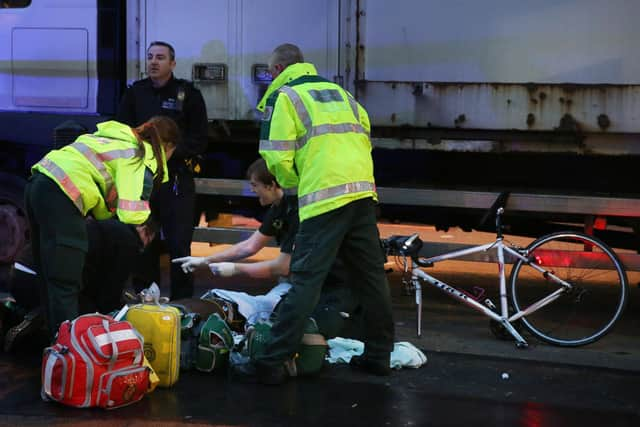Scotland can learn from London about how to cut cyclist deaths involving lorries – Denise Hamilton
After good progress on road safety in Scotland for several years, fatalities and serious injuries on our roads have increased again. The overall number of fatalities increased from 141 in 2021 to 173 in 2022, with the increase significantly higher in Scotland than elsewhere in the UK.
People cycling continue to be disproportionately represented in road safety data: they account for only 1 per cent of traffic but 10 per cent of serious casualties. On average, four people cycling suffer a serious crash every week.
Advertisement
Hide AdAdvertisement
Hide AdRather than accepting that a rise in deaths and serious injuries is inevitable as more people cycle, we need to prioritise safety interventions in order to prevent them, as many European countries successfully have. So what needs to happen?
The top priority for creating a safer environment for cycling is a network of cycle routes, separated from vehicles and pedestrians. Road safety awareness is also key and starts in primary school where Bikeability Scotland, the national cycle training, teaches young people essential knowledge and skills to safely use the roads. Even countries where the majority cycle, like the Netherlands, provide cycle training for children, ensuring road safety is part of their education.
Deadly blind spots
As well other important, long-term actions for road safety, the design of large vehicles, and how they’re operated in Scotland, has to drastically change. It’s been tragically clear for far too long that these vehicles pose a fundamental risk to people walking or cycling and it's the role of national and local government and HGV operators to tackle these risks.


More large vehicles are moving goods across the country and a disproportionately high number of crashes involve people driving for work. We urgently need to take steps to improve them, including legal requirements for additional safety measures, such as improved visibility, blind-spot mirrors and sensors, alongside training to raise drivers’ awareness of safety around people walking or cycling.
It extends to public procurement and planning processes, which should incentivise fleet operators to invest in raising standards, by stipulating minimum safety requirements when awarding public supply chain and construction contracts, and approving planning applications – policies which have been introduced with success in London. Fatal collisions involving lorries where vision was a contributing factor were reduced by three quarters in London between 2018 and 2023.
Online reporting system
Multiple actions are needed to ensure people using our roads are safe. Enforcement activity is critical, both by cameras and police, and has a proven impact on tackling the Fatal Five – drink/drug driving, careless driving, no seatbelt use, speeding, and distraction such as mobile phone usage.
As has happened in Wales and across England, Scotland urgently needs an online third-party reporting system so dashcam and other footage can be used to take action against dangerous driving. The police can’t be everywhere but the public can – and organisations from Cycling UK to Roadpeace rightly continue to campaign on this.
Accepting deaths and serious injuries as an inevitable cost of driving is unfathomable. Scotland has a long-term aim of zero deaths or serious injuries on our roads by 2050. Let’s do everything in our power to get there.
Denise Hamilton is head of communications at Cycling Scotland
Comments
Want to join the conversation? Please or to comment on this article.
